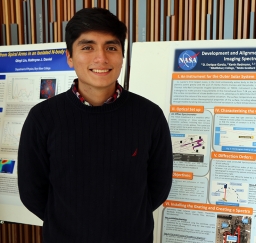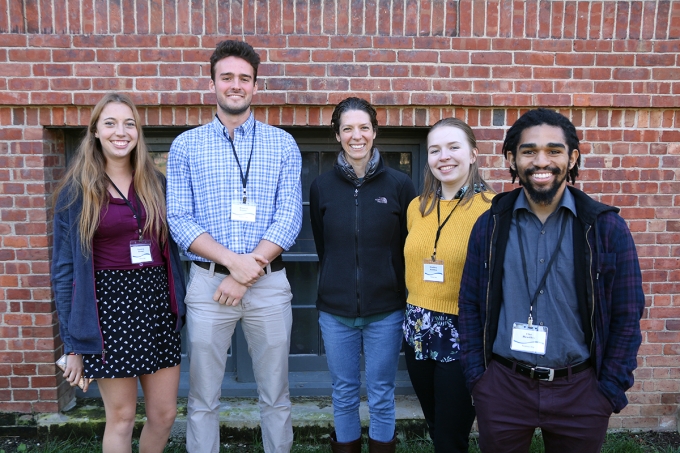Physics Majors Present Research at Astronomy Conference – Middlebury College News and Events
Click image to enlarge
Diego Garcia ’20 presents his poster based on work at NASA’s Goddard Space Flight Center at the 2019 KNAC Symposium. Garcia worked on a prototype infrared instrument that may one day find its way to the outer solar system.
MIDDLEBURY, Vt. — Four Middlebury students, along with undergraduates from seven other colleges and universities, presented findings from their research at the 2019 Symposium of the Keck Northeast Astronomy Consortium (KNAC). Hosted by Vassar College on October 4 and 5, the symposium was attended by more than 120 participants.
Middlebury’s Assistant Professor of Physics Eilat Glikman, Professor Emeritus of Physics Frank Winkler, and telescope and scientific computing specialist Jonathan Kemp attended the symposium alongside Middlebury students.
“The symposium is a stimulating environment for all students of astronomy,” said Kemp. “Some of the students had presented their research before, while for others it was their first opportunity to share their research with fellow students and faculty. The symposium provides inspiration to pursue research opportunities and a venue to meet faculty, make connections, and gain knowledge about subfields and career paths as well as issues of importance to young astronomers.”
The packed schedule of events also included four breakout sessions with KNAC faculty members on topics ranging from applying to graduate school to astronomy and Mauna Kea, and from methods of communicating science to creating video games for pedagogical use in astronomy.
 |
|
Lauren Fossel (Williams College), Dan Gause ’20, Middlebury Assistant Professor of Physics Eilat Glikman, Lindsey Gordon (Wellesley), and Ché Bradley ’21 at the 2019 KNAC Symposium. |
The consortium was founded in 1990 with funds from the W. M. Keck Foundation, and its eight member institutions are Colgate University, Haverford College, Middlebury College, Swarthmore College, Vassar College, Wellesley College, Wesleyan University, and Williams College.
Currently funded by the National Science Foundation (NSF) under its Research Experiences for Undergraduates (REU) program, KNAC promotes student astronomical research and fosters interaction among students, faculty, and staff across the eight campuses.
During the two-day symposium, there were 21 talks given by 24 students and 13 posters presented by 20 students.
Ché Bradley ’21 and Williams sophomore Lauren Fossel presented a group talk titled “What’s All that Noise? An Investigation of the Faint Radio Properties of Quasars,” based on research performed at Middlebury last summer and funded by KNAC’s NSF-REU program. Bradley and Fossel analyzed observations obtained by the Very Large Array in New Mexico of quasars in the area of the sky known as Stripe 82. Their investigations support the possibility of a more diverse population of quasars than was previously known, suggest that star formation can cause increased radio emission in quasars, and reveal that fainter quasars are more compact and brighter at radio wavelengths, improving our understanding of the sources of radio emission in quasars.
Sadie Coffin ’19 gave a talk based on her NSF-supported research performed at Middlebury last summer titled “Supernova Remnants in M51: A Spectroscopic Analysis to Confirm and Catalog Supernova Remnants in the Whirlpool Galaxy.” Coffin analyzed observations obtained by Gemini Observatory and the Hubble Space Telescope. Her investigations of emission lines and elemental abundances will result in a first catalog of supernova remnants in the iconic face-on Whirlpool Galaxy, a well-known nearby interacting system, and will provide more information about the properties of stars before they become supernovae.
Dan Gause ’20 and Wellesley junior Lindsey Gordon presented a group talk titled “Double Trouble: The Search for Dual Quasars” based on research performed at Middlebury last summer and funded by KNAC’s NSF-REU program. Gause and Gordon analyzed observations obtained by the Hubble Space Telescope and Apache Point Observatory of known quasars. Their investigations identified candidate dual quasar systems, potentially supporting the theory that large galaxies may form from the collision of smaller galaxies each with its own quasar, and supporting theoretical predictions of the density of dual quasars in the observable universe.
Diego Garcia ’20 presented a poster based on his research performed this past summer at NASA’s Goddard Space Flight Center titled “Development and Alignment of the Thermal Infrared Composite Imaging Spectrometer (TIRCIS) Instrument.” Garcia’s NASA-supported research involved development of a prototype infrared instrument for a future space mission. Designed for the study of outer solar system bodies, this instrument would advance our understanding of objects like the volcanically active Io, Jupiter’s third largest moon.
Participants at the symposium arrived on Friday afternoon and attended a reception, banquet, and discussion at Ely Hall in Poughkeepsie. On Saturday, there was a full schedule of events at Sanders Classroom and the Bridge for Laboratory Sciences on Vassar’s campus.
In addition to the students’ posters and presentations, the president-elect of the International Astronomical Union, Professor Debra Elmegreen of Vassar, delivered the welcome address, and Assistant Professor Colette Salyk of Vassar gave opening remarks.
The next KNAC Symposium will be held during the autumn of 2020.





